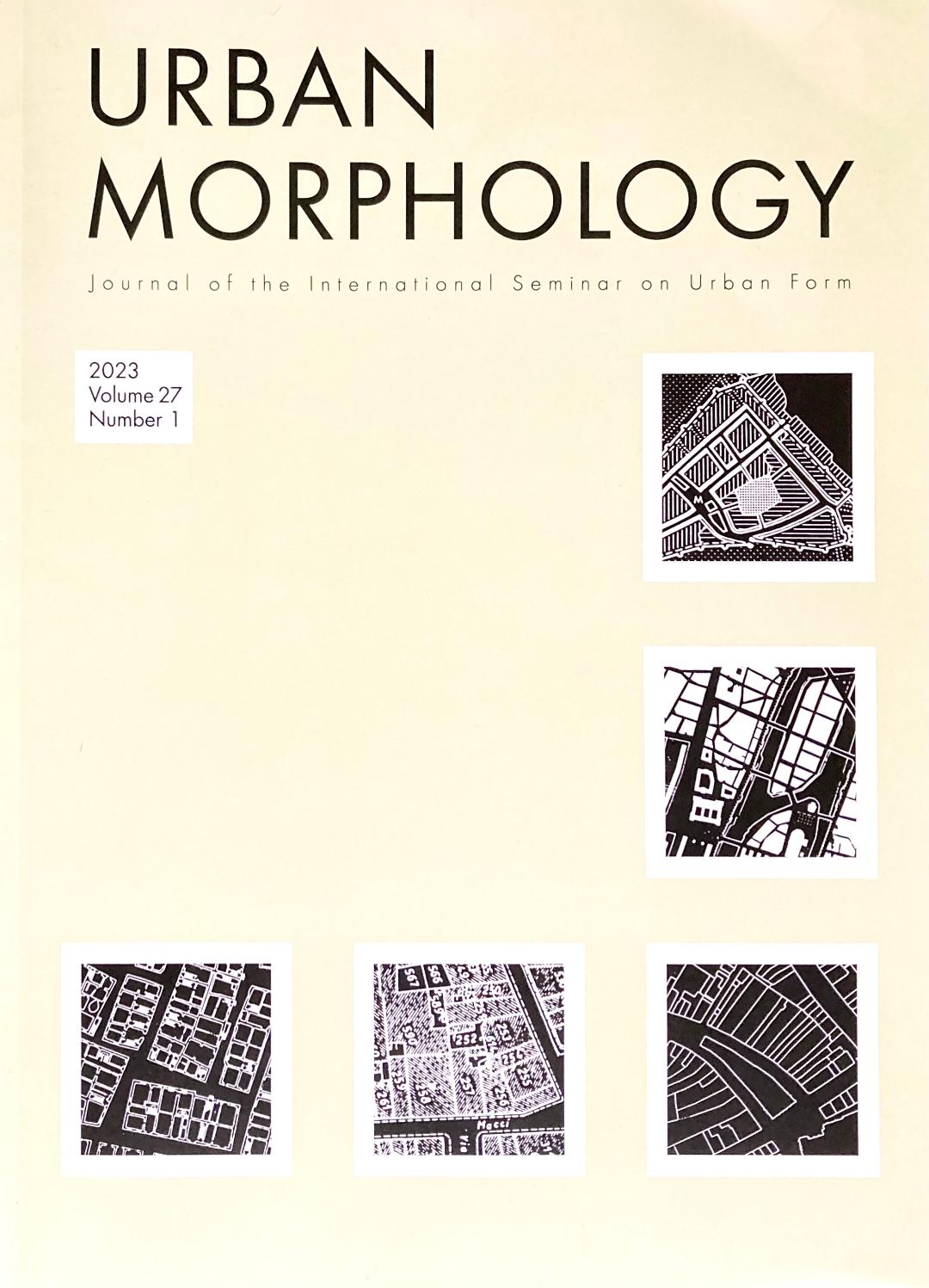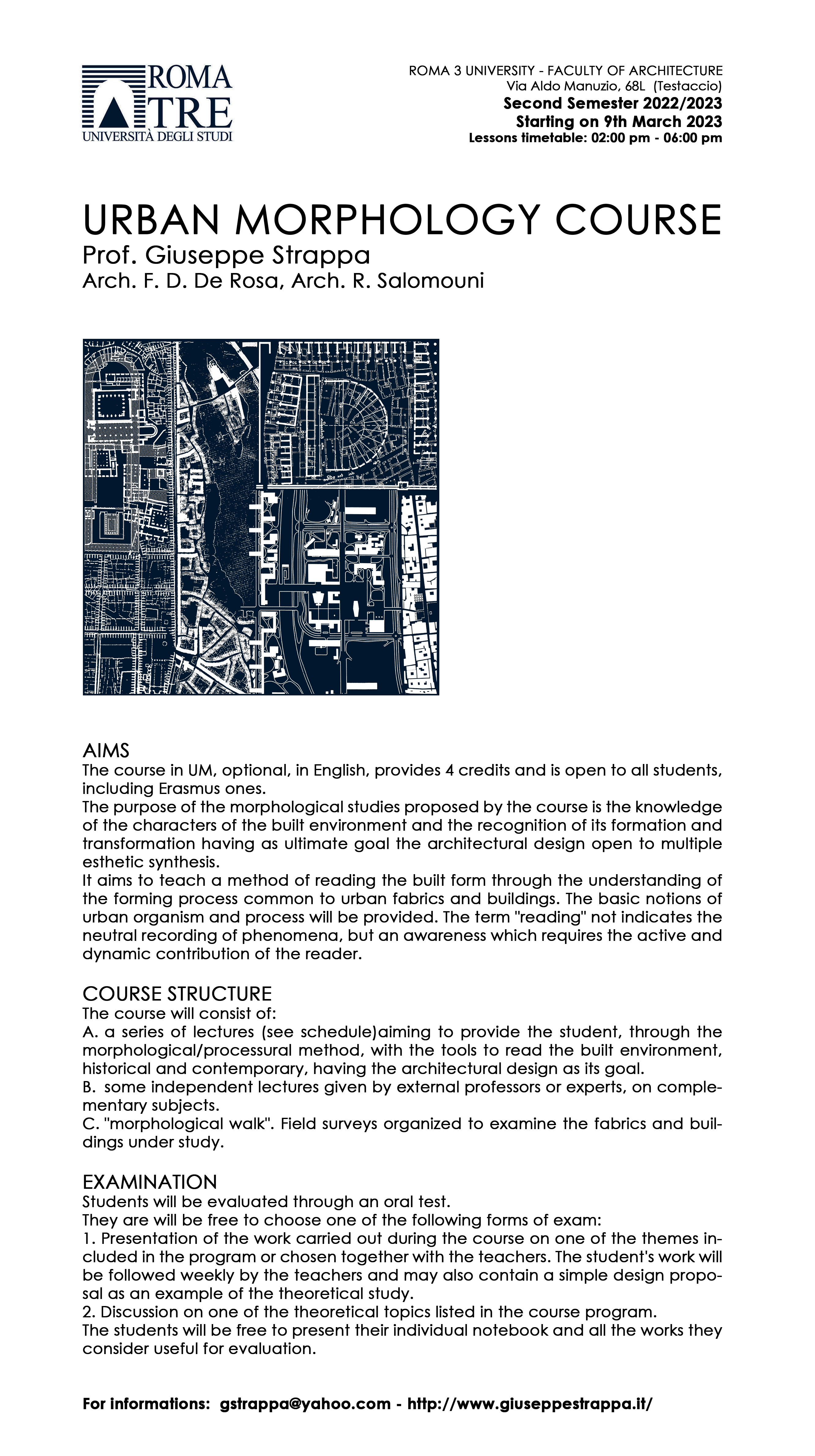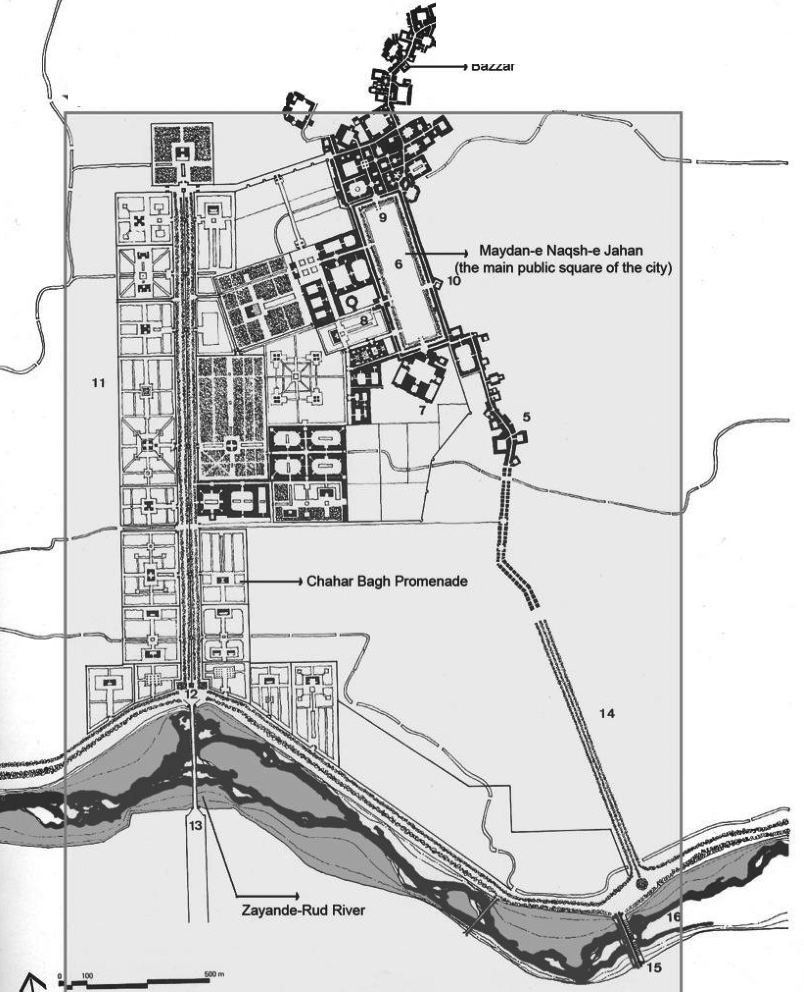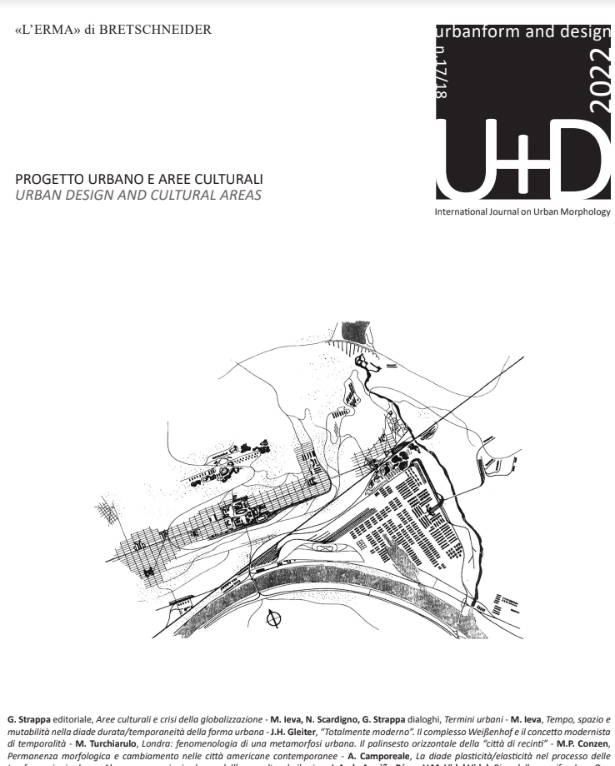G. STRAPPA
THE PROBLEM OF TEACHING URBAN MORPHOLOGY AND THE ISSUM EXPERIMENT
in Urban Morphology n.1, vol 27 , 2023

G. STRAPPA
THE PROBLEM OF TEACHING URBAN MORPHOLOGY AND THE ISSUM EXPERIMENT
in Urban Morphology n.1, vol 27 , 2023


FOR INFORMATION, mail gstrappa@yahoo.com
PROGRAM
The course in Urban Morphology, optional, in English, provides 4 credits and is open to all students, including Erasmus ones.
The purpose of the morphological studies proposed by the course is the knowledge of the characters of the built environment and the recognition of its formation and transformation, having as ultimate goal the architectural design open to multiple esthetic synthesis.
It aims to teach a method of reading the physical form of the city through the understanding of the forming process common to urban fabrics and buildings, The term “reading” not indicates the neutral recording of phenomena, but an awareness which requires the active and dynamic contribution of the reader.
The basic notions of urban organism and forming process will be provided.
CONDUCT OF THE COURSE
The course will consist of:
EVALUATION METHOD
Students will be evaluated through an oral test. They will choose one of the following forms of exam:
Documents required:
The students will be free to present their individual notebook and all the works they consider useful for evaluation.
ADOPTED TEXTS
BasIc text in online format (in English)
The main chapters translated into English (useful to take the exam) can be found on the teacher’s website (http://www.giuseppestrappa.it/) and are indicated below:
Basic text in paper format (in English)
A good translation in French (online) is: G. Caniggia, G.L. Maffei, Composition architectural et typologie du bati. 1 lecture du bati de base, traduit par p. larochelle, Université Laval, 2000 –http://www.giuseppestrappa.it/wp-content/uploads/2018/01/G.-Caniggia-Lecture-du-b%C3%A2ti-de-base-traduit-par-P.-Larochelle.pdf
—————————————————————
LECTURES CONTENT AND ACTIVITIES
Introduction. Meaning and utility of Urban Morphology for the contemporary architecture.
Course organization. Presentation of the program. Student registration.
Territory: notion, forming process and contemporary condition.
Matter Material: notion, transformation process, contemporary condition
Substrata and urban fabric: the physical form of the city: notion, forming process and contemporary condition.
Base building and substratum: base elements of the city: notion, forming process and relationship with urban pre-existence.
Field Survey: on base building topics.
Special building: forming process and contemporary examples.
Architectural knotting: historic notion and transition to modernity. – Classroom work presentation (only for students who intend to deepen the topics of the course with practical exercises – see Exam 1 in the program).
At the roots of architectural composition: the notions of assembly and aggregation in history and in the contemporary condition.
Field Survey on special building topics
Roman modern architecture
Conclusion. Short recap/summary of the course main topics (for the exam) and conclusions. Student opinions and suggestions.
Short pre-examination test (optional)
Iniziare il nuovo per studiare le radici
di Mazyar Abee (da U+D 17-18)

English text Notizia – Abaee (1)
Nel corso dell’ISUF 2019 a Nicosia, in alcune conversazioni con Vítor Oliveira, è nata l’idea di una rete iraniana di morfologia urbana. Con il suo incoraggiamento, è stato deciso di proporre il progetto di un’indagine sugli studi della forma urbana in Iran con lo scopo di prendere in rassegna i principali studiosi di morfologia urbana in questo paese. Il progetto si è concluso con un articolo pubblicato sul Journal of Urban Morphology nell’aprile 2022 (Abaee, 2022). Parte degli studiosi che hanno affrontato il problema della forma urbana in Iran con un chiaro approccio disciplinare, si sono riconosciuti nella costituzione di un network iraniano. Va detto, tuttavia, che lo studio della forma urbana in Iran soffre di alcuni problemi linguistici, terminologici e disciplinari. Considero un grande onore, per me, aver presentato quest’anno il lavoro di costruzione di una rete iraniana al consiglio dell’ISUF durante la conferenza di Lodz e Cracovia. Negli ultimi mesi, il network iraniano di morfologia urbana ha beneficiato del generoso sostegno di Giuseppe Strappa e Vítor Oliveira. Siamo ora ai primi passi della sua costituzione. Mi fa quindi piacere annunciare la collaborazione dei colleghi che lavoreranno alla rete iraniana (in ordine alfabetico): Mazyar Abaee (Direttore di ricerca e formazione, Urban Planning and Architecture Research Centre of Iran), Zahra Ahari (professoressa, Shahid Beheshti University, Tehran), Pantea Alipour (docente, University of Art, Teheran), Eisa Esfanjari (professore assistente, Art University of Isfahan, Isfahan), Toofan Haghani (assistente professore, Islamic Azad University, Central Tehran Branch, Tehran), Nasim Iranmanesh (instructor, Islamic Azad University, West Tehran Branch, Tehran), Mahta Mirmoghta Daee (Direttore del Dipartimento di Planning and Urban Design; Road, Housing, and Urban Development Research Centre),Azadeh Mohajer Milani (University of Tehran, Tehran), Maryam Mohammadi (Professore associato, Islamic Azad University, West Tehran Branch, Teheran), Mohammadreza Noghsanmohammadi (professore associato, Yazd University, Yazd,) e Homeira Shayesteh (Senior Lecturer, Middlesex University, Londra.) La rete iraniana si rammarica di non beneficiare, in questa prima fase, della collaborazione di un importante studioso internazionale del settore come Kayvan Karimi (Senior Lecturer, The Bartlett School of Architecture, UCL, London e Direttore della Space Syntax Ltd.). Siamo comunque grati di ricevere il suo generoso sostegno. Se la nuova rete iraniana di morfologia urbana sta ora muovendo i primi passi, hanno invece radici antiche gli studi sulla forma urbana in Iran che si occupano delle trasformazioni storiche, delle innovazioni contemporanee e della complessità della città attuale. Stiamo iniziando a costruire la rete come un “ nuovo arrivato” che si propone l’obiettivo d’indagare, studiare, comprendere, analizzare, valutare incontrando quanto è già consolidato.
editoriale di U+D n.1718
di Giuseppe Strappa

Questo numero della rivista è dedicato al progetto urbano considerato nel suo rapporto con gli studi sulla forma della città che generano, o almeno spiegano, scelte, disegni, programmi. Nella convinzione che le indagini sulla morfologia urbana siano esse stesse un prodotto dell’ambiente in cui sono maturate, il numero è dedicato anche al tema della formazione e persistenza della nozione di “area culturale” nella condizione contemporanea. Argomento familiare non solo alla scuola muratoriana (si pensi, senza scomodare Vitruvio, alle tante ricerche dei geografi moderni, da Friedrich Ratzel a Carl Sauer). Ma esistono ancora le aree culturali, intendendo con questo termine ambiti sociali, geografici, politici nei quali si è consolidato un insieme di valori, linguaggi, tecniche condivise? In una fase della storia, peraltro, nella quale tutto sembra coesistere, tutto partecipare di uno comune universo, da quello delle immagini a quello economico, all’interno del quale la città si trasforma?
La questione delle specificità legate al contesto pone per noi architetti, in realtà, l’altro problema, assai arduo, della circolazione delle idee e dei progetti di architettura…..
CONTINUA A LEGGERE Editoriale n.17-18 – Strappa